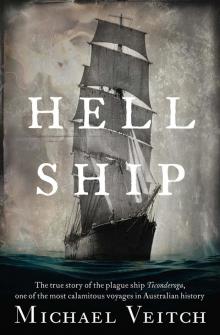- Home
- Michael Veitch
Turning Point Page 10
Turning Point Read online
Page 10
At 8.30 a.m., the Bettys and their escorts roared away from Rabaul, while the men at Milne Bay, unaware of the fate they had narrowly avoided, were left to ponder yet another day of skies conspicuously devoid of their enemy.
•
For the Japanese, it was all in vain. That first day of the Guadalcanal campaign was a disaster, in which the Australian Coastwatchers played a vital part – and particularly one of the unlikeliest of heroes, Paul Edward Mason.
Originally from Sydney, Mason had travelled to Bougainville in the Solomons at just fifteen to help his brother, a trader. He fell in love with the place then stayed to run a plantation of his own, after the previous owner had been hacked to death by disgruntled employees. Though short, bespectacled and sporting a slight speech impediment, as well as ‘prominent teeth’, Mason was a born diplomat, showed great respect for the local culture and successfully navigated the complex web of tribal politics. He also knew the place like the back of his hand, and was a genius with a wireless – which made him an ideal recruit to Commander Eric Feldt’s Pacific network of Coastwatchers.
From his jungle eyrie on Bougainville’s south-eastern tip, Mason had first alerted the Americans to the Japanese landing and airstrip construction back in June, after which he reported on all the comings and goings of the Japanese shipping. Then, on the morning of 7 August, as the massive fleet of 82 US warships began landing eleven infantry battalions on Guadalcanal, Mason looked up and counted the Betty bombers and Zeros heading towards them from Rabaul. He then tapped out a message that would become legendary: ‘Twenty-four bombers headed yours.’
These few words were relayed via Townsville to Pearl Harbor, then, a minute later, to the US ships at Guadalcanal. Forty-five vital minutes was thus handed to the Americans, who immediately suspended their landing operations, ordered their ships to weigh anchor and assume anti-aircraft dispositions, then pulled their men off the exposed beach. Furthermore, the Wildcat fighters from the carrier Saratoga were scrambled and in position in step formation high above Savo Island, and they pounced upon the Japanese aircraft when they appeared. The American ships then put up a wall of anti-aircraft fire, making the attack a disaster for the Japanese. In the attack on this day, and in another mounted 24 hours later, no less than seventeen G4M Betty bombers of the 4th Air Group were destroyed, with the remainder damaged.
Paul Mason would spend almost the entire war in his beloved Solomons, hunted constantly by the Japanese, but managing always to stay one step ahead. In late 1944 he was invalided out with pneumonia, only to return shortly thereafter, leading a band of local partisans, which by the war’s end would claim to have killed upwards of 2000 Japanese. Awarded both the American and the Commonwealth Distinguished Service Cross, Paul Mason survived the war, and for the rest of his life remained an unsung Australian hero.
In truth, the Japanese would have been far better off persisting with their original plan to attack Milne Bay. Now, with the opening of the Guadalcanal campaign, the Japanese forces would be dispersed even further, to yet another front at an even more distant part of the Pacific. The Rabi plan was still a top priority, but would become a wholly naval operation, under the organisation of the newly formed 8th Fleet Headquarters. The Imperial Japanese Army forces originally earmarked for the invasion, including the crack Kawaguchi Detachment, would instead be redirected to Guadalcanal.
Outwardly, the men of the navy were proud to be conducting this vital mission all on their own, and looked forward to regaining some of the prestige lost after the defeats of the Coral Sea and Midway. Privately, however, some regretted that there would now be no help whatsoever from the army.
CHAPTER 13
NIPPON’S MARINES
The men of Japan’s Kaigun Tokubetsu Rikusentai, translating roughly as the Special Naval Landing Force (SNLF), have been described as the marines of Imperial Japan, but the comparison is only partly accurate. Like the United States Marine Corps, the SNLF were regarded – at least during the first half of the Pacific War – as an elite amphibious infantry force which specialised in storming and holding beachheads and accomplishing other difficult military objectives. But while the numerous divisions of the US Marines functioned independently from other branches of the armed services, Japan’s SNLF was formed under and remained the exclusive tool of the Imperial Japanese Navy. Their very existence, in fact, arose from the longstanding enmity between the Japanese Army and the Japanese Navy – a situation which condemned Japan’s war effort to poor levels of cooperation between the services and enormous wastage of resources.
The bad blood went back decades. Following the 1905 Battle of Tsushima, when Japan’s new and as yet untested warships shocked the entire world (not least the Japanese themselves) by demolishing the fleet of Imperial Russia, it was decided that seagoing troops were needed to secure ports and other enemy strongpoints. Rather than relying on the fiercely jealous army to lend troops, however, the navy trained some sailors in infantry and battle tactics. By the late 1920s, these coalesced into standing SNLF regiments of between around 750 and 1600 men, each taking its name from the naval districts in which the men had been raised and trained: Kure, Maizuru, Sasebo and Yokosuka.
The term ‘special’ in Special Naval Landing Force did not denote that these troops were ‘special forces’ in the modern military sense; rather, it signified the SNLF’s unique role, in that once the military objective had been attained, the men would revert to their role as ships’ crewmen and return to sea.
Experiencing a baptism of fire in Manchuria in the early 1930s, the SNLF quickly took on the mantle of an elite force, well trained in the use of light artillery and amphibious operations, high in morale, and seeing much action in the Second Sino-Japanese War, then later in Japan’s eruption of conquests across South-East Asia in 1941–42.
At the beginning of the Pacific War, sixteen SNLF regiments were in existence, but that increased to 21 over the course of the conflict. In Malaya and the Philippines, SNLF forces acted as the tip of the spearhead in Japan’s favoured shock tactic of sudden attacks by sea, with men screaming onto enemy shores, officers waving Samurai swords, cutting down enemies with ruthless and overwhelming force. In 1941, three units of the Yokosuka SNLF were converted into parachute regiments; they would eventually make more combat jumps than regular Japanese Army soldiers, onto islands such as Celebes and Timor.
As the war progressed, and Japan’s fortunes quickly soured, SNLF units suffered commensurate casualties, fighting till their ammunition was exhausted, then resorting to hand-to-hand fighting. Almost always they refused to surrender. Overwhelmed by the sheer might of the Allies, their numbers waned rapidly, with entire regiments sometimes ceasing to exist after a single engagement. By late 1943 the SNLF regiments were a spent force, with few members surviving the war.
Notably, various units of the SNLF became directly responsible for many of Imperial Japan’s most heinous wartime atrocities, committed across their conquered territories against prisoners and civilians alike. The shocking acts perpetrated by the SNLF at Milne Bay would be among Japan’s darkest crimes of the entire war.
•
In mid-1942, the 1200 men of the 5th Kure SNLF, though yet to be blooded in battle, believed themselves to be invincible and were itching to prove it. Having trained for months now, they had heard fabulous stories of the Emperor’s forces sweeping the white enemy before them. Like dominos, colonial bastions, having remained inviolable for centuries, were brushed aside like cardboard castles by the skilful and devoted Japanese warrior. Malaya, the Philippines, Rabaul and even the great British base at Singapore had caved in, their contemptible defenders not even having the honour to die in battle, but surrendering shamefully, and in droves. Soon it would be their turn to write themselves into the history books by opening the final phase of the New Guinea campaign, and securing the southern flank of Japan’s new Pacific Empire.
Underlying this confidence was a plan so bold and so brilliant that failure was unthinkable.
/>
At the Japanese base at Rabaul, the commanding officer of the SNLF’s 5th Kure, Commander Masajiro Hayashi, listened intently as his superiors outlined the plan to capture the Australian and American base at Milne Bay. It would be an amphibious night attack, involving 612 soldiers brought up the bay by the ships of the 18th Cruiser Division and delivered close to the airstrip.
Hayashi’s men would disembark quickly, then advance up a narrow coastal track to whatever Australian defences awaited them, overwhelm them and secure the landing strip. Supporting them would be 197 men from the 5th Sasebo SNLF, under Lieutenant Susumu Fujikawa, along with several hundred auxiliary and construction troops and labourers, many of them Koreans who had been as good as press-ganged into service with promises of pay which never eventuated. The force would be supported by a number of Type 95 Ha-Go infantry tanks, which were light and fast and would tear through the enemy’s ranks.
So swift would be the victory that an air force construction party and maintenance unit would be landed at the same time, so they could begin immediate preparations for the arrival of Japanese aircraft. Bombs and aircraft fuel would be carried in the holds of the ships so the planes could start operating almost immediately.
Meanwhile, the 5th Sasebo’s main force of 353 troops would be landed at Taupota, on the coast to the north of the Australians, and strike out twelve miles or so overland, linking up with Hayashi’s men as they approached from the east. The defenders of Milne Bay would be pincered and overwhelmed, and a viable airstrip ready for use was the prize. Within hours, Japanese aircraft would be roaring off the runway and attacking Port Moresby, which would now lie barely an hour’s flying time away; what’s more, the Japanese pilots would no longer have to negotiate those dreadful mountains.
The task would not be difficult. The Australian defenders were estimated to number only a handful and, as had been demonstrated in Singapore and other places, were green and contemptible, likely to surrender at the first shots than put up any kind of fight.
Then, with Japanese control of the air and the surrounding sea lanes, the advance on Moresby would begin in the form of an even larger two-pronged offensive: from Milne Bay in the east, while from the north General Tomitaro Horii’s South Seas Force advanced along the track from Buna and Kokoda. With Port Moresby secured, Australia itself would be under threat – and, with her northern sea lanes in Japanese hands, would be checkmated out of the conflict.
After this the fight would be taken to the Americans in Guadalcanal, and with the airstrip there secured, the entire eastern flank of Japan’s new empire would be secure. The war itself could then be wrapped up in months.
The Rabi plan was bold and brazen, and called for fit and determined men to move with lightning speed through jungle terrain. The men of the 5th Kure believed themselves up to the task, and were brimming with confidence, as indicated by the first paragraph of their official battle plan, which was captured along with a swathe of important documents after the battle:
At the dead of night quickly complete the landing in the enemy area and strike the white soldiers without remorse. Unitedly smash to pieces the enemy lines and take the aerodrome by storm. For this reason strict control of sound and light is most important and every endeavour must be made to maintain secrecy of the plan.
Commander Masajiro Hayashi was an experienced naval officer who had seen action in the Philippines and Rabaul. As writer and Milne Bay veteran James Henderson discovered while researching his small but excellent volume on Milne Bay, Onward Boy Soldiers, the paymaster of the 5th Kure, Captain Chikanori Moji, kept one of the few surviving Japanese diaries during both the preparation period and the campaign itself; Henderson was also able to interview him after the war. Its contents, and Moji’s recollections, are revealing. He recounts that the men were in high spirits and anxious to get into the fight in the week before the campaign began. Commander Hayashi, however, harboured serious doubts about the entire venture.
While the men were entranced by the apparent endless tide of victories believed to be Japan’s military destiny, Hayashi was acutely aware of the setbacks, compromises and delays that had brought them to this point in August 1942. The lightning pace of the war unleashed the previous December had seen Japan’s goals only partially achieved, and now things were slowing down. The timetable for the capture of Port Moresby, originally intended for May, was seriously behind schedule.
Hayashi had in fact been part of the original amphibious invasion force of eleven transports and 5000 soldiers when it steamed, full of confidence, out of Rabaul harbour. Then, after entering the Coral Sea and just a day or two from their goal, they had made a sudden 180-degree turn and steamed back to Rabaul. Just out of sight over the horizon, the US carriers Yorktown and Lexington – which Japanese intelligence had completely failed to notice – let loose their aircraft on the escorting Japanese carriers, sinking the Shoho and damaging the Shokaku. The Moresby convoy, dangerously exposed, had headed back to harbour, and the invasion was ‘unavoidably deferred’.
Hayashi was also hearing rumours that General Horii’s thrust towards Moresby from the north was in trouble. The mountain country of the Owen Stanley Range, he had been told in furtive whispers, was diabolical, and the Australian soldiers, far from the paper warriors they had expected, were proving tough, determined and increasingly adept at jungle fighting. So tortuous was the terrain over which Horii’s men were required to march that only such equipment as could be carried on their backs was taken, the remainder being abandoned to rust and rot beside the track.
In any case, pondered Hayashi, what chance had a group of exhausted and underequipped infantry of taking and holding a vital and defended enemy port such as Moresby, after they’d had to fight every inch of the way, and without the support of heavy artillery?
If they failed to take Moresby, Japan’s forces in the South Pacific would be strung out along a long and vulnerable line, which the gathering strength of the United States would be eager to sever. From Hayashi’s point of view, General Horii’s situation suddenly imbued the capture of Moresby with an urgency, even desperation. And desperation was a state in which no commander ever wanted to find himself.
If only the momentum of earlier in the year had not been lost, Hayashi mused. If the task force had continued on after its capture of Rabaul in January – before the might of the United States could begin to mobilise – then Moresby might already be in their hands. Milne Bay’s value had been appreciated by Japan months earlier, but instead of moving quickly, the Allies had been allowed to slip in and take it for themselves. Then had come the shock of the news of the American landings on Guadalcanal. As heartened as Hayashi was by the confidence of his men, he knew they would need every bit of it, especially as they were going in without the support of the army.
Something else Hayashi had begun to notice: the skies above his head, formerly throbbing with countless Japanese aircraft, had become decidedly quieter these last few months. Air protection at Rabi was, he sensed, no longer guaranteed. This was not shaping up as the short, dynamic war that had been promised.
Most unsettling, however, was the question of what, exactly, his men would face at Rabi. In the last days of July, Paymaster Moji observed an increasing level of anxiety in Commander Hayashi. ‘He was clearly agitated and his brows were constantly wrinkled,’ he recalled after the war. Day after day, in the leadup to the departure of the task force, he had been observed taking long walks with the senior navy commanders, and returning in a dark mood.
Eventually, Hayashi disclosed to Moji that no proper reconnaissance – either of the terrain or the enemy’s dispositions – had been undertaken, mainly due to the weather, and what few aerial photographs they had were inconclusive. His own requests to accompany such a flight were continually refused. Nor, incredibly, were there any accurate maps of the area, meaning the exact position of the vital Allied airstrip could only be speculated. It was assumed to be at Rabi, but no-one really knew.
The same w
ent for the strength of the Australian defenders. The more Hayashi asked for details, the more he found them to be vague and based on guesswork. His men, he sensed with increasing dread, would be going into battle blind.
CHAPTER 14
STRIKE FROM THE AIR
Despite the limitations imposed on them by the opening of the Solomon Islands campaign, the Japanese still regarded the capture of Milne Bay as an absolute priority, and on 11 August they returned to Rabi with a show of air power that would demonstrate to the Australians just what a formidable opponent they were up against.
The 4th Air Flotilla was now down to just 22 serviceable bombers with which to soften up Milne Bay before the impending invasion. Escorted by Zeros, the raid was to be timed close to midday, when it was hoped that many of the Kittyhawks would be on the ground, transitioning from the morning patrols to the afternoon, and many of the personnel would be preparing for lunch. When they got close to the target, however, the bay’s characteristically foul weather closed in, splitting up the formation and obscuring the target. Lost, the bombers turned back, but were unable to contact the Zero escort, which pressed on.
Almost every modern source varies on just how many Zeros made it to Milne Bay on 11 August; estimates range between six and twelve. What is not in dispute is that the daring young Japanese pilots slipped under the clouds and flew straight up the bay from the sea. This proved to be a mistake, as the open sea provided the only clear direction from which the now fully operational No. 37 RAAF Radar Unit could detect an incoming enemy, free of the obscuring mountains to the north and south.
Radar, in fact, was just one of the timely warnings which should have given the Australians the upper hand that day. Even if the higher figure of a dozen Zeros was correct, they were still outnumbered by as many as 22 Australian aircraft alerted to their presence. Sixty miles to the north, on Fergusson Island, a spotter had been installed, who was able to radio back to Gili Gili a warning: ‘Bandits coming your way.’ Out on the water that morning, in a small skiff, another group of spotters was being brought back to Gili Gili – one of their number needing medical attention. Seeing six aircraft approach at mast height, they jumped to their feet and waved with delight. Only when the planes were almost overhead – and the faces of the pilots clearly visible – did their red circle markings become apparent. The waving quickly stopped. Taking no chances, a group of locals on board jumped into the sea – but the Zeros had bigger targets in mind.

 Turning Point
Turning Point Heroes of the Skies
Heroes of the Skies The Forgotten Islands
The Forgotten Islands Hell Ship
Hell Ship Flak
Flak Fly
Fly